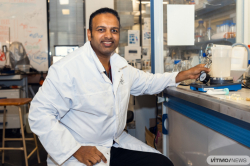What happens to people throughout their life? They fall ill, get treatment, and receive services from various medical providers: clinics, hospitals, etc. Each of these cats generates new medical data. And even though the providers change throughout one’s life, each of us continues to generate data until the very end of our lives.
It only makes sense that a medical specialist would like to be able to have the total sum of all that data when treating a patient. But that either doesn’t happen at all, or only to some degree. Not every clinic has the capacity to store everything digitally, and not every patient is able to aggregate all of their data. When every doctor must learn about the patient on their own, it’s hard to maintain a continuity of medical care.
Today, we face a new generation of technology that will make it possible to share medical data on a global scale. We could provide timely access to all sorts of vital information to any certified user at any time and in any language. All the incidental patient-provider interactions will become part of a cohesive process that provides patients with life-long continued medical care. Such care will be more effective and cheaper.
What is continuity of care?
“Continuity of care” refers to a cohesive, sequential process of maintaining a patient’s health according to their changing needs. This is a process based on the entirety of a patient’s data as acquired by various providers. When we change doctors, we often lose that data and break the continuity.

Continuity of care is impossible if a system can’t process data generated by other systems. It’s hard to imagine how collection, storage, and transfer of data might change in some 80 years. We also can’t tell what will happen to the range of available data. For example, no clinic did genetic testing 20 years ago like they do today.
A new data exchange architecture is forming. Specialists in data-driven medicine are creating medical data operators, an innovation in the field of healthcare. The operators’ main function is to accumulate data and share it with interested parties on the market. Patients can use the operators to manage their own data, e.g. decide whether to provide access to some parts of it, monitor its quality and how it’s used by doctors. In a way, the patient now becomes a data provider and a full-on member of their own medical care team.
Interoperability
In this new system, patients, providers, and data are all interconnected. Now we have to decide how to provide patients with the means of sharing their data with others.
Semantic interoperability is what we use to handle access to data. It is the ability of any entity in the system (patient, specialist, or data system) to process the information in the same manner even if it was not originally meant for such purposes.
What’s the issue?

A great deal of medical data needs to be standardized. Globally, we have acquired around 10 zettabytes (1021 bytes) of medical data, of which:
- 50% are physical (paper) records;
- 30% is digitized, non-structured data (such as *.pdf documents where doctors write down their observations);
- 10% are voice recordings;
- 10% is data contained within reports and publications.
Only 20% out of all that data is organized, and there is a lot of work to be done in terms of converting physical records to digital data. On average, providers on the market create around 80 megabytes of data per each patient every year, and that’s not taking into account complex radiology tests.
Interoperability calls for standardization. Specialists must introduce common standards regarding data storage and transfer protocols, as well as data semantics and clinical models.
What makes clinical models so important?
A clinical model is a set of parameters that outlines medical conditions and processes related to diagnostics and treatment. These models exist to help sort, analyze, formalize, structure, and standardize data for clinical use. Clinical models ensure the continuity and quality of medical care.
These days we already use models such as Medical Data Standards, LOINC, openEHR, and many others. One format that’s been quite popular lately is FHIR (Fast Health Interoperability Resources), which can be used to establish an effective clinical system and describe all of its properties and entities: patients, doctors, their responsibilities, work schedules, and so on.
Such technology is quickly becoming a part of our everyday life. Quite soon we’ll control our own data, collect it and manage its usage. And that information will become a highly valuable resource for providers.





